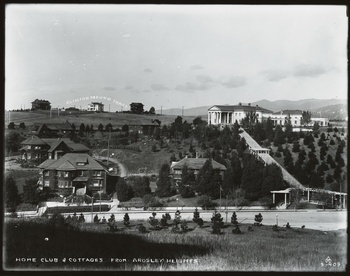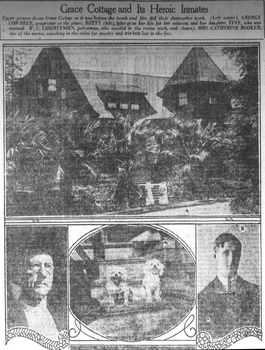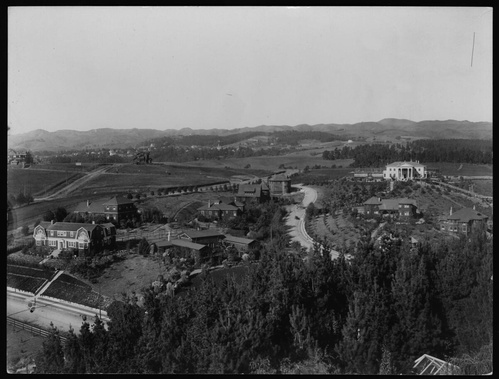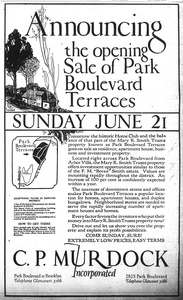Mary R. “Mollie” Smith, the first wife of “Borax” Smith, founded an orphanage, the Home for Friendless Girls. It was in operation from 1901 through at least the 1920s, 8,11 though the Mary R. Smith Trust which ran it continued for many years after that providing scholarships and other support.
Beginnings
Mary R. Thompson married F. M. “Borax” Smith in 1875. After reading Benjamin Farjeon’s Blade O’ Grass about orphans in London, Mary was inspired to begin supporting a number of girls. In 1901, Frank gave her between 16 and 34 acres just north of their estate and they created the Mary R. Smith Trust, and Mary started the Home for Friendless Girls. The trust was governed by a board of trustees of women of the First Congregational Church. The first child came to the orphanage in February 1901, and was cared for in a temporary cottage. 12
The Lodge
The Home for Friendless Girls included a central intake office, known as “The Lodge” at the corner of Park Boulevard (then 4th Avenue) and McKinley Avenue (then Cottage Avenue). It was built by George W. Flick, who also built several of the cottages. It was built for $5,158, furnished for $1,387, and dedicated December 6, 1902.
In 1910, Jessamine Green was the secretary, and lived in The Lodge with her daughter Roberta Green. By the 1920 census, Roberta had married Bliss Jackson, and Roberta and Bliss are also listed at the address. The 1930 census lists Jessamine, still working for the Mary R. Smith Trust, and Roberta Green (Jackson) living with her.
The Lodge is now a private home at 2901 Park Blvd. Its front room still contains a built-in desk from its days as an office, and beautiful architectural details are preserved throughout the house. On April 23, 1985, The Lodge was designated an Oakland Landmark, under Zoning Case #LM 84-414.
The Lodge
photo from Our Oaklandinside The Lodge
photo from Our Oaklandbuilt-in desk in the office
photo from Our Oakland
The Home Club
The Home Club served as a community center and central clubhouse for the orphanage, and stood near Grace Cottage. From the beginning it was also used as a general community center which clubs could rent for their use.
The building could be reached via a driveway off of Cottage Avenue, or a by long arbor-covered stairway up from Fourth Avenue. It was designed by architect Walter J. Mathews, built in 1903-04 for $25-$30,000 with furnishings valued at $15,000, and dedicated March 24, 1904.
At the same time, a club called the Home Club was organized with the purpose of "the betterment of homes." The building was leased to the Home Club by the Mary R. Smith Trust. Mary R. Smith was the honorary president; Ethel Moore served as the first president. 14
In 1906, an art gallery, gymnasium, and library were added next to the main hall. 15
In 1910, F. H. Drake was the head of The Home Club, and lived there with his wife Nellie Drake, son Glenn B. Drake, daughter Mollie R. Drake (White), and son-in-law, Charles A. White.
The building was torn down in 1958 for the expansion of Oakland High School. 9
The Cottages
There were 9 cottages around the grounds where the girls lived, a number of which are still standing and are now private homes or were converted into apartments. The cottages were named for young women the Smiths knew: Evelyn, Florence, Grace, Josephine, Lila, Mae, Marion, which included 5 of the members of the "Solid Six." Several of the cottages were designed by well-known architects. Each cottage had its own endowment fund, and was run semi-independently by a house “mother”. (Special thanks to Phil Bellman who leads the Oakland Heritage Alliance “Borax” Smith tour and provided many of the details on the cottages.)
Initial Cottage
Initial Cottage, despite the name, was not the first cottage built; it was where orphans new to the system were “initially” placed (provisionally) until the cottage to which they were best suited could be determined. It was designed by George W. Flick, built for $4,350, and dedicated in 1902.
The cottage was also used for new “mothers” to see if they were a good fit for the system. In 1904, Miss Emily Hahn was the house mother. In 1905, it was Mrs. Eva Brand. In 1909 it was Mary Herrick. In 1917 it was Laura Smith.
The building still stands at 23-27 Home Place West. On April 23, 1985, the Initial Cottage was designated an Oakland Landmark, under Zoning Case #LM 84-417.
1910 Residents
| Name | Age | Notes |
| Katharine Saunders | 31 | house mother; widowed |
| Hilda Kent | 16 | |
| Bertha Remer | 13 | born in Texas |
| Daisy Hosford | 12 | born in Massachusetts |
| Amy Howe(?) Hanford | 11 | |
| Mabel Remer | 11 | |
| Lunette Faure | 6 | |
| Dorothy Marie Williams | 10 m. |
Marion Cottage
Marion Cottage was the first cottage built in 1901, 4,12 and was designed by Bernard Maybeck. Reportedly the Smiths refused to pay his $400 fee, considering it exorbitant. The fee was later reduced to $250, which they paid.
Mrs. Carrie C. Boettcher was the house mother from c.1904 to c.1910. Mrs. Maude E. Graham was the house mother in 1916.
The building is still standing at 2817-23 Park Boulevard, though remodels have covered many of the details. Documented in records at the Bancroft Library showing a contract between Mary R. Smith and BR Maybeck (source: Oakland Survey records), and is significant because it is one of only a few Maybeck buildings still standing in Oakland.
1910 Residents
| Name | Age | Notes |
| Carrie C. Boettcher | 50 | house mother since c.1904; widowed |
| Edna P. Boettcher | 19 | daughter |
| Lilian Beals | 12 | |
| Leona McLoud | 12 | born in Nebraska |
| Violet Crewe | 12 | |
| Mabel Jones | 10 | |
| May Anna Burdge | 7 | |
| Martha L. Hunt | 4 | born in Nevada |
Florence Cottage
Florence Cottage was designed by Walter J. Mathews in 1901. The building still stands at 1125-29 McKinley Ave.
In 1904-1905, Mrs. Clara Burt was the house mother. In 1910-1911, it was Florence Owen.
1910 Residents
| Name | Age | Notes |
| Florence Owen | 39 | house mother |
| Bonnie Dale Overall | 20 | bookkeeper, printing house |
| Alfreda Johnson | 19 | stenographer, typewriter company |
| Maybelle Denny | 17 | |
| Ethel Denny | 15 | |
| Katherine Gallo | 18 | |
| Anna Teresa Hesketh(?) | 14 | |
| Marguerite Viers | 14 | |
| Hazel E. Viers | 10 |
Josephine Cottage
Josephine Cottage was designed by George W. Flick, built for $5,300 and dedicated by 1901. It still stands at 1 Home Place East.
The cottage was ready for its first residents in August 1901. 12 In 1904-1905, Mrs. Annie E. Errauw was the house mother. In 1909-1910, it was Helen Mills. In 1917, it was Anna Drew.
1910 Residents
| Name | Age | Notes |
| Helen Mills | 45 | house mother |
| Irene Alexander | 19 | |
| Charlotte Schuster | 17 | born in Montana |
| Marian Noble | 12 | |
| Ruby J. Gore | 12 | |
| Minnie M. Creed | 10 | born in Oregon |
| Josephine Cooper | 9 | |
| Ada Louise Gorge | 9 |
Evelyn Cottage
Evelyn Cottage was named for Evelyn K. Ellis, a ward the Smiths had taken in, who worked as Mary "Mollie" Smith' personal secretary, and who became the second wife of Frank "Borax" Smith after Mary passed away. The cottage was designed by Julia Morgan, built for $5,900 and dedicated on December 28, 1906.
In 1909-1911, Emily T. Hahn was the house mother.
The home still stands at 3001 Park Boulevard. On April 23, 1985, Evelyn Cottage was designated an Oakland Landmark, under Zoning Case #LM 84-415.
1910 Residents
| Name | Age | Notes |
| Emily T. Hahn | 52 | house mother |
| Myrtle Lilian Babcock | 14 | |
| Pearl Frances Hill | 13 | |
| Minnie Troussaint | 14 | |
| Gertrude F. Groff | 10 | |
| Lolita M. Groff | 13 | |
| Ethel Lillian Struthers | 8 | born in Canada |
| Marian Isabel Struthers | 6 | born in Canada |
| Evelyn Price | 4 |
Evelyn Cottage
photo from Our Oakland 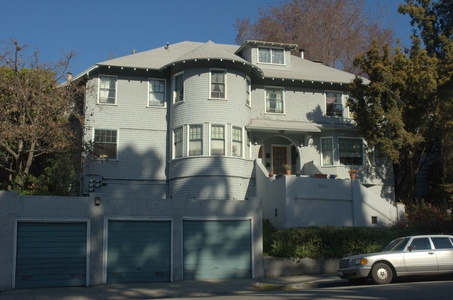 Evelyn Cottage
Evelyn Cottage
photo from Our Oakland
Grace Cottage
Grace Cottage was designed by architect George W. Flick and completed in February 1903. 12 After a 1922 fire gutted the house’s upper stories, it was rebuilt as a one-story house.
In 1904-1905, Gertrude Allen was the house mother. In 1909-1911, it was Agnes Cooke.
The building still stands at 1101-1105 McKinley Avenue. On April 23, 1985, Grace Cottage was designated an Oakland Landmark, under Zoning Case #LM 84-412.
1910 Residents
| Name | Age | Notes |
| Agnes Cooke | 49 | house mother |
| Maud Elizabeth Hine | 14 | |
| Helen Hine | 10 | |
| Viola Ida Brown | 14 | |
| Grace McPeters | 13 | |
| Lila Parkinson | 12 | |
| Bernice Parkinson | 10 | |
| Charlotte Grace Wolfe | 6 | |
| Margaret Edwards | 6 | born in Nevada |
Grace Cottage
photo from Our Oakland
Mae Cottage
Mae Cottage was designed by Julia Morgan in 1904, 3 but is no longer standing. It was named for Anna Mae Burdge Miller, one of the "Solid Six."
In 1906, Mrs. Eva Brand was the house mother. In 1909-1910, it was Frances Witherly. In 1917, it was Emily T. Hahn.
The home was demolished prior to 1927-1928, as two apartment buildings (Seville and Cordova) were constructed in that location.
1910 Residents
| Name | Age | Notes |
| Frances Witherly | 48 | house mother |
| Vivian Warren | 22 | worked as a clerk, art store |
| Bertha Reid | 19 | |
| Mildred Wilson | 16 | |
| Frances Wilson | 14 | |
| Jean Reid | 13 | |
| Helen Beach Cole | 11 | |
| Lilabel Corte | 10 | |
| Ione Wilson | 9 |
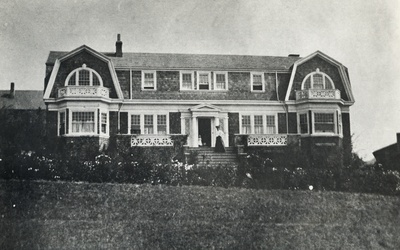 Mae Cottage courtesy Julie Mangano
Mae Cottage courtesy Julie Mangano
Lila Cottage
NB: Lila Cottage is not to be confused with Lilac Cottage, which stood on the grounds of Arbor Villa.
In 1906, Frank C. Havens donated $85,000 for the endowment of the cottage. It was named Lila Cottage for his wife, Lila Havens. 5
In 1909-1910, Mary "May" Elizabeth Black, widow of Albert L. Black, was the house mother of Lila Cottage, and their daughter Dorothy lived there with her.
Lila Cottage is no longer standing.
1910 Residents
| Name | Age | Notes |
| M. E. Black | 39 | house mother |
| Dorothy Vera Black | 10 | daughter |
| Irene Mabel Elliott | 17 | born in Pennsylvania |
| Stella Mabel Price | 15 | |
| Violet Rippon | 15 | born in Wisconsin |
| Ethel Russel | 13 | born in Canada |
| Adele Narinian | 11 | |
| Hannah Johnson | 9 | |
| Lila Sterling | 3 |
Mary Evelyn Cottage
The Mary Evelyn cottage was at 3025 Park Boulevard, and was designed by Charles W. Dickey. It appears to have been built in 1910, probably the last of the cottages constructed. 7 It is no longer standing.
Other references
From Past & Present of Alameda County, California (Vol II, S. J. Clarke Publ. Co., 1914):
"Any girl that is in need of a home and worthy of aid is admitted to the cottages and she is always allowed to stay as long as necessary. There are from five to eight in a cottage and the ages are from four to twenty-five years. There has only been one death on Cottage Hill since the work was undertaken and there have been five marriages there. All of the girls attend the public schools, several have been high-school graduates and one has been graduated from the university. Another has been a student in the San Francisco Art Institute and several attend the Normal School. The number includes nurses, stenographers and teachers. They make most of their own clothes and help with the housework and have a real home life, under the direction of a matron in each cottage."
From an S.F. Chronicle article, “A Revolution in the Orphan Asylum System”, Sunday, October 11, 1903:
Just across the way from F.M. Smith’s magnificent East Oakland home the “Mary R. Smith Cottages” are nestled on a flower-bedecked hillside, close enough together to form a sociable group, far enough apart to preserve their individuality. Indeed, “individuality” may be said to be the watchword of this community.
See the 1912 Sanborn map of the area showing the locations of the cottages, The Lodge, and The Home Club: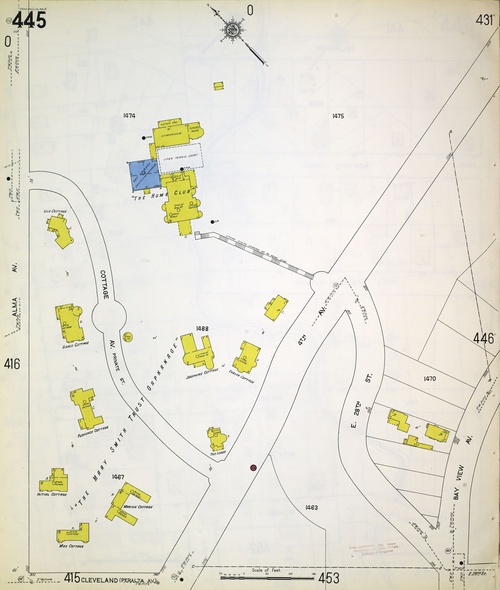 1912 Sanborn excerpt showing "The Mary Smith Trust Orphanage"
1912 Sanborn excerpt showing "The Mary Smith Trust Orphanage"
(note that 4th Avenue is now Park Boulevard, and Cottage Ave. is now McKinley Ave.)
The End
By 1922, Grace Cottage was being used by George Cowdrey as a sanitarium. 6
A 1924 article quotes Evelyn Ellis Smith:
"Then came the years of the war, with inflated prices and increased costs. We were confronted with the problem of either fully caring for a small number, or partially taking care of a great many. We chose to do the former, and have been working on that basis ever since.
"A short time ago, due to the rise in property values in East Oakland, we decided to sell off our property and establish ourselves in a location not quite so costly. Some of the property has already been sold and negotiations made for most of the rest. Within a year and a half at the least the trust hopes to be established in a new location. When this is done, the seventeen girls we are now caring for will be increased many fold, and the activities of the trust increased." 11
Only Josephine Cottage and The Home Club (which by that time had become independent of the cottages) are labeled on the 1928 Sanborn as they were on the 1912. The rest were converted to private homes or apartments, or demolished: the Lodge is labeled as a dwelling, Marion Cottage divided into 3 dwellings, Mae Cottage demolished, Initial Cottage divided into 3 apartments, Florence Cottage divided into 3 flats, Lila was demolished, Evelyn divided into 4 apartments, and Mary Evelyn divided into 2 flats. (As noted above, Grace Cottage had become a sanitarium by 1922 and had a serious fire.) Note that Mrs. Jessamine Green was still living in what had been the Lodge in 1930, and was still working for the Mary R. Smith Trust.
A 1943 article about continuing the trust says "Scarcity of available orphan girls forced trustees to close the home in 1934." 8 Whether the 1924-1934 period was in a new location, or in one of the remaining cottages (likely Josephine) isn't yet known.
Links and References
- BANC PIC 1983.123:20--PIC UC Berkeley Bancroft Library collections
- Mother To A Hundred Girls San Francisco Chronicle December 22, 1901
- The Meddler Oakland Tribune April 16, 1904
- Smith Cottage Is Dedicated By Dr. M'Lean Oakland Tribune April 29, 1901
- The Meddler Oakland Tribune April 7, 1906
- Bomb Fires Sanitarium; Five Rescued Oakland Tribune August 31, 1922 (p2)
- Ninth Cottage Home For Young Women Oakland Tribune February 28, 1910
- Orphan Girl Fund Continues Oakland Tribune December 10, 1943
- Old Pioneer House to Be Torn Down Oakland Tribune August 2, 1958 (p2)
- View of Oakland showing The Home Club in the distance, CHS-40167 USC Libraries and California Historical Society
- Recovers On Girls' Aid Realty Sales Oakland Tribune August 18, 1924
- A Revolution in the Orphan Asylum System San Francisco Chronicle October 11, 1903
- ad for sale of Park Boulevard Terraces Oakland Tribune June 20, 1925
- Betterment of Homes Object of Recently Organized Club Oakland Enquirer March 2, 1904
- Splendid Building on the M.R. Smith Trust Property Oakland Enquirer August 26, 1906
- 1904 Husted's Oakland Directory
- 1905 Husted's Oakland Directory
- 1906 Husted's Oakland Directory
- 1909 Husted's Oakland Directory
- 1911 Polk-Husted Oakland Directory
- 1917 Polk-Husted Oakland Directory
For Additional Research
- Author search: Trustees of Mary R. Smith's Trusts Oakland Public Library, Oakland History Center


